by Claire Davis | Mar 25, 2022
Being in the great outdoors is a great way to spend your time with family! What are some ideas for activities you can do outdoors with your friends and family? Some of the best outdoor activities could include going for a hike, swimming, hunting, kayaking, or even building a campfire. With the weather still cool and a little dry here in Northwest Florida, sitting around a campfire sounds like the right kind of fun! However, it is extremely important to be sure that your campfire does not put anyone at risk of wildfires or burns.
Check out some of the fire safety tips below!

- Use a designated fire pit, if available. If this is not an option, clear a space on the ground, removing any grass or needles that could potentially catch fire.
- Build your fire downwind and away from tents, houses, or anything that is flammable. What does flammable mean? Anything that can easily set fire is flammable. The USDA suggests a minimum of at least 3 feet away from anything that can catch fire.
- Have water or something to douse the fire nearby. In the event of fire escaping its designated area, you will need to be able to put it out swiftly to prevent a wildfire. Consider a water hose that is hooked up to a water source or a fire extinguisher. Also, before leaving your fire site, make sure the fire is extinguished!
- You know the drill! Stop, Drop, and Roll! Make sure that everyone present knows how to put out a clothing fire with these three simple steps.
- Never leave children unattended around a fire. As the adult, it is your responsibility to make sure that everyone is safe! Also, store matches, lighters, and lighter fluids out of children’s sight and reach.
- Think about what you are wearing. Do not wear open toed shoes, as a spark could come off a flame and burn your toe. Instead, wear closed toed shoes while around the fire. Do not wear loose fitting clothing. If you lean over a fire with a baggy t-shirt on, chances are your shirt could catch on fire. Wearing snug-fitting clothing is an easy way to prevent this from happening.
Another “hot” topic is grilling! As we all know, fire and charcoals are extremely hot. Make safe cooking a priority, especially when it comes to outdoor grilling. With summer coming, grilling will become a more popular activity!
A great way for you youth to learn about safe grilling practices is for them to attend a 4-H Tailgate Grilling Camp! This summer,

Youth learning to grill pork safely!
Calhoun and Liberty County 4-H Agents, Claire Reach and Marie Arick will be teaming up to offer this program to area youth. Youth will not only learn about the importance of fire safety, but also how to mix rubs or marinades for their meats, and how to grill different animal proteins!
If this is something you think your child or a youth you know might be interested in, stay tuned for upcoming date announcements for summer camps. If you have questions, comments, or concerns, please give us a call at the UF/IFAS Extension Calhoun County Office: (850)-674-8323.
An Equal Opportunity Institution.
Sources:
https://www.firesafekid.org/family-fire-safety/outdoor-fire-safety/
https://www.usfa.fema.gov/downloads/fief/outdoor_fire_safety.pdf
by Claire Davis | Feb 11, 2022
Like me, you make ask, what is a “sense of belonging”? Have you ever felt out of place when going to a club, meeting, or gathering? Do you remember how it made you feel? Maybe you were nervous, had a funny feeling in your stomach, a knot in your throat, or weren’t sure if you belonged?

Volunteer working with youth. Calhoun County Animal Science Camp 2021
One of the essential elements of 4-H Youth Development is belonging. Youth members need to know that they are important to you, cared for by others, and feel a sense of connection to the group they are in! As a facilitator of a 4-H activity, whether that be volunteer, adult, or Extension agent, it is important to provide youth with a safe, inclusive environment when participating in groups. When the facilitator creates a space where youth feel physically and emotionally safe, youth tend to form positive relationships with their peers and role models. Feeling connected to others will affect their behavior, mental health, academics, as well as other life skills. Creating this sense of belonging for all participants is a solid foundation to build a program on!
Now you may be asking, how on earth can I create a sense of belonging?
Since you are the adult facilitator in this setting, it’s your job to provide youth with the opportunity to feel safe during activities. To do this, use discussion questions that engage all the youth members, and encourage them to learn from each other. Below are a few ideas to foster this sense of belonging.
- Welcome new members. Youth who are already part of the group will feel more comfortable than those that are just starting. Assign existing members a role in welcoming newcomers, similar to a welcoming committee. 4-H and other group activities like team sports, can be overwhelming because there is a lot of information given, so think about preparing welcome packets for new members or families. These packets could include information on how to enroll in 4-H Online, club calendars, brochures, frequently asked questions, contact information, and more!
- Ice breakers. Ice breakers and team building activities are really important to help all members feel
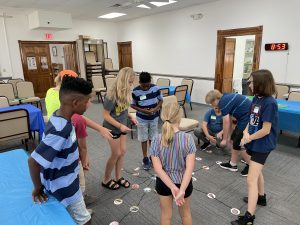
Calhoun County Animal Science Camp Ice-Breaker. What is Agriculture? Summer 2021
comfortable with each other! These types of interactions help build relationships within the group. These are helpful when a group is just starting out, as well as continuing to build bonds overtime. Being deliberate in choosing these types of activities will help any group feel more cohesive. Adjust the activity to suit the group that is participating. Keep it simple for cloverbud age youth (5-7) or add challenges if the group is older or has been together for a period of time. “Ice breakers, get acquainted games, or even roll calls that ask questions about member’s interests (answer roll by making the sound of your favorite animal) can help members get to know each other better.” (Kent, 2015)
- Create a safe space. It may seem easy to create a safe space for youth and other adults but it’s much more difficult in practice! We all think about keeping youth safe physically, but what about the emotional aspect of safety? We must be aware of “microaggressions”, which is defined as a statement, action, or incident regarded as an instance of indirect, subtle, or unintentional discrimination against members of a marginalized group such as a racial or ethnic minority. As a leader, you will want to be able to identify these so you can educate and redirect the situation. It is our job, as adults, to help youth, and other adults, understand the impacts of their words. Creating a shared set of ground rules for everyone to follow can help everyone feel comfortable, knowing the expectations of the group as well as having a voice in creating the space.
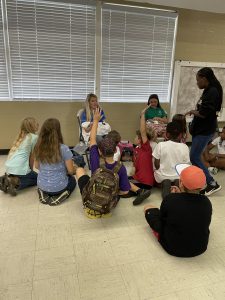
Intro to Animal Handling- Gulf County Summer Camp 2021
- Encourage engagement. Engaging youth members can be done in multiple ways! Various options include using discussion questions, club committees, or even silly ice breaker games – anything constructive to grab and hold their attention. Using discussion questions allows youth to learn from each other while also encouraging a sense of curiosity for life-long learning. Having different committees allows for smaller work groups, which is much less intimidating than a single large group. It is easier for opinions and thoughts to be heard in a smaller setting. Ice breakers may seem silly, but they are a fun and wonderful way to get youth involved.
While a sense of belonging is important for youth, it may take some time and intentionality to create the space to provide the sense of belonging. Our youth members come from all different walks of life and as the adult leader, you must think about the challenges youth may face that makes them different. Some youth may look different physically; some may come from a family that has never done 4-H; some may have experienced trauma; some may have special needs.
A 4-H club, program, or activity can provide a space that youth belong to, as well as allowing them to learn invaluable life skills. Adults, volunteers, and agents are essential to creating this space, while also helping other members see how to increase the sense of belonging for others. What will you do to help make all members feel welcome?
Sources:
https://www.canr.msu.edu/news/essential-elements-of-4-h-belonging
Creating a Welcoming Environment in 4-H Clubs
by Claire Davis | Aug 9, 2021
 Claire Reach is the UF/IFAS 4-H & Family and Consumer Sciences Agent in Calhoun County, Florida. Claire grew up part time in Birmingham, Alabama and on her family’s farm, L & L Angus Farm, in Auburn, Alabama. The family farm is Claire’s driving force behind the passion that she has for the Agriculture side of 4-H. One of her favorite memories growing up is during calving season. “I remember the excitement of waking up early every morning to check on new calves, it was like Christmas morning, every morning!”
Claire Reach is the UF/IFAS 4-H & Family and Consumer Sciences Agent in Calhoun County, Florida. Claire grew up part time in Birmingham, Alabama and on her family’s farm, L & L Angus Farm, in Auburn, Alabama. The family farm is Claire’s driving force behind the passion that she has for the Agriculture side of 4-H. One of her favorite memories growing up is during calving season. “I remember the excitement of waking up early every morning to check on new calves, it was like Christmas morning, every morning!”
 Claire studied Animal Science-Production Management at Auburn University in Auburn, Alabama. While completing her undergraduate degree, Claire competed for Auburn University’s Intercollegiate Horse Show Association, worked at Auburn University’s College of Veterinary Medicine in a research barn, and continued to work on the family farm. She graduated in May of 2019 with her Bachelor of Science and a minor in Agricultural Business.
Claire studied Animal Science-Production Management at Auburn University in Auburn, Alabama. While completing her undergraduate degree, Claire competed for Auburn University’s Intercollegiate Horse Show Association, worked at Auburn University’s College of Veterinary Medicine in a research barn, and continued to work on the family farm. She graduated in May of 2019 with her Bachelor of Science and a minor in Agricultural Business.
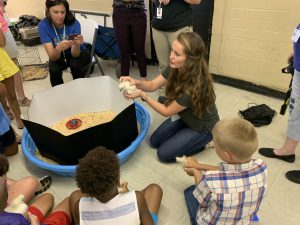 Claire recently moved to Florida in 2020 to work for Deseret Cattle and Timber, but soon realized that her passion was Extension. The position in Calhoun County became available and she jumped at the opportunity to apply for it. While Claire has not been with Extension long, she cannot wait to see what the future holds for her county. Claire says that she aspires for the Calhoun County Florida 4-H to area’s leading youth development program by creating positive change in youth, families, and communities as its members grow and share through hands-on learning and fun. “I hope that the 4-H program here will help our youth with developing their life skills and their passion for a lifetime of learning!”
Claire recently moved to Florida in 2020 to work for Deseret Cattle and Timber, but soon realized that her passion was Extension. The position in Calhoun County became available and she jumped at the opportunity to apply for it. While Claire has not been with Extension long, she cannot wait to see what the future holds for her county. Claire says that she aspires for the Calhoun County Florida 4-H to area’s leading youth development program by creating positive change in youth, families, and communities as its members grow and share through hands-on learning and fun. “I hope that the 4-H program here will help our youth with developing their life skills and their passion for a lifetime of learning!”
For more information on 4-H, please contact your local 4-H office. You can find your local office here.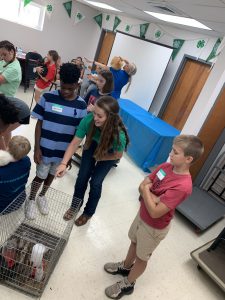
by Claire Davis | Jul 5, 2021
 Summer is upon us and so is the heat in the Florida Panhandle. Schools are out and the kids are at home needing activities to do together. Homemade Freezer Pops are an excellent source of fun! These popsicles can be secretly healthy and taste absolutely delicious. They don’t have to just be for the kids either, adults of all shapes and sizes can enjoy them too. In this article we will discuss what freezer pops are, how to make them, and a few tips for maximum enjoyment!
Summer is upon us and so is the heat in the Florida Panhandle. Schools are out and the kids are at home needing activities to do together. Homemade Freezer Pops are an excellent source of fun! These popsicles can be secretly healthy and taste absolutely delicious. They don’t have to just be for the kids either, adults of all shapes and sizes can enjoy them too. In this article we will discuss what freezer pops are, how to make them, and a few tips for maximum enjoyment!
What are Freezer Pops?
A freezer pop is a frozen treat that generally comes in a clear, plastic tube. Freezer pops, not to be confused with popsicles which are typically consumed off a wooden popsicle stick, are found in grocery stores in unfrozen liquid form, ready for the consumer to pop them into their freezer at home! Once frozen solid, the consumer picks their flavor of choice, cuts open an end of the plastic tube, and simply squeezes or pushes the sweet ice out of the packaging.
Many of us know these sweet and fruity slushy pops as Otter Pops or Fla-Vor-Ice. These nostalgic treats are simply made from sweetened, colored, and flavored water. With little nutritional value coming from the store-bought version, homemade freezer pops can be much more nutritious. Keep following along to find out how to make these tasty treats!
How to make Homemade Freezer Pops
Freezer pops are super easy to make and are a healthier alternative to the nostalgic treat. Before you get started, you will need all the necessary supplies. Supplies commonly found at home would include a freezer and a blender. Supplies that can be bought at the store are Zipzicles (a freezer pop reusable plastic bag) or silicone ice pop molds, fruit of your choice, and a natural sweetener like honey.
Step 1: Wash your hands! Handwashing is one of the best ways to protect yourself and others from spreading germs. You should wash hands before, during, and after preparing your food. To wash your hands the right way, first wet your hands with warm, clean, running water. Then turn off the tap and apply your soap. Lather your hands (make lots of white foams/bubbles) by rubbing them together with the soap. Make sure you lather the back of your hands, between your fingers, under your nails, and palm of your hands. Scrub for about twenty seconds. (Don’t know how long 20 seconds is? Hum the “Happy Birthday” song from the beginning to the end twice!) Finally, rinse your hands well under warm, clean, running water and either dry with a clean towel or air dry. (1)
preparing your food. To wash your hands the right way, first wet your hands with warm, clean, running water. Then turn off the tap and apply your soap. Lather your hands (make lots of white foams/bubbles) by rubbing them together with the soap. Make sure you lather the back of your hands, between your fingers, under your nails, and palm of your hands. Scrub for about twenty seconds. (Don’t know how long 20 seconds is? Hum the “Happy Birthday” song from the beginning to the end twice!) Finally, rinse your hands well under warm, clean, running water and either dry with a clean towel or air dry. (1)
Step 2: Gather your ingredients to be blended. There are lots of fruits that make great homemade ice pops: watermelon, orange, pineapple, mango, raspberry, honeydew, cantaloupe, and strawberry! (3)
One of my favorite recipes for freezer pops uses 10 ounces of ripe berries, ~½ a cup of water, and 1-2 tablespoons of honey. If the fruit you use is very juicy, you may not have to use as much water but remember, the more water that you use, the icier the pop will become in the freezer. You can also use either lemon or lime juice to add a little flavor boost!. (3) The amount of sweetener needed varies as the sugar content of the berries can vary. If the berries are ripe and sweet, use a little less sweetener. If the berries are not as ripe, simply use a little more sweetener. Then blend all the ingredients together completely, until smooth!
Step 3: Fill individual baggies of your choosing. Make sure to not over fill the bags.
Step 4: Freeze the freezer pops for ~ 2 to 4 hours before enjoying. If you consume them around 2 hours, they may not be as solid as they will be at the 4-hour mark.
Step 5: Enjoy a refreshing treat!
Tips for Homemade Freezer Pops
- The sweetness of the chosen fruit will be muted once frozen. Make sure to use over ripe fruit or added sweetener to keep the treat sweet.
- Use a funnel to fill your freezer pop bags. Using a funnel will keep you from making too much of a mess, and will also help you mind the “maximum fill line” on the bag. If you keep the contents you are pouring into the bag under the line, it will be easier to seal! \
- Just about anything that can be blended or pureed can be used for a freezer pop! Leftover smoothies, various fruit juices, and even sodas make for easy treats! Check out the image below to see flavors others have created! (4)
For National Freezer Pop Day, July 8th, 2021, enjoy making homemade freezer pops with your family! With a snip of the scissors, you’ll produce smiles with every sip. (2)
by Claire Davis | Jun 22, 2021
 In the Panhandle of Florida, we are starting to get into the heat of the summer. With temperatures soaring, your sweat is going to start pouring. It is extremely important to replace the fluids lost through sweating. In this article we will cover what hydrated versus dehydrated means, why it is important, and tips on how to stay hydrated in the Florida heat.
In the Panhandle of Florida, we are starting to get into the heat of the summer. With temperatures soaring, your sweat is going to start pouring. It is extremely important to replace the fluids lost through sweating. In this article we will cover what hydrated versus dehydrated means, why it is important, and tips on how to stay hydrated in the Florida heat.
What is Hydration, and Why Does it Matter?
Hydration is the process of introducing our body to additional fluid (i.e. water). Dehydration is when you have used or lost more fluid that you are taking in. Your body is unable to continue functioning properly without fluids. Staying hydrated may seem like a difficult task, but it is extremely important for us to stay hydrated for optimal health and performance throughout the day. “Drinking enough water each day is crucial for many reasons: to regulate body temperature, keep joints lubricated, prevent infections, deliver nutrients to cells, and keep organs functioning properly. Being well hydrated also improves sleep quality, cognition, and mood.” (1) Without staying hydrated, we can seriously harm ourselves. Whether you are considered youth or an adult, you can still lose approximately 40 percent (2) of your body’s water during hard work or exercise.
How to Stay Hydrated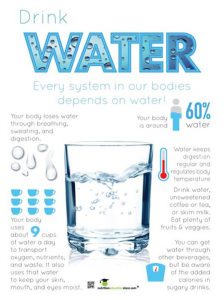
- Drink lots of fluids: Don’t wait till you are or feel thirsty to drink. By the time that you feel this, you are already slightly dehydrated. It is important to drink fluids, preferably water, throughout the day. During the summer, while it is hot, it should be a top priority to replenish fluids lost in our body. A good way to start the day is by drinking a glass of water when you wake up and get your body going. Fluids are fluids, but some fluids are better for us than others. When replenishing the fluids that we have lost through sweating, make sure that it is mainly from water. Some of the fluids can also be from flavored water, tea, or coffee. Try not to consume as many sugar-sweetened beverages, as many of them act as a diuretic. The sugar found in these drinks tends to draw the water out of your cells, making you feel thirsty a short time after drinking it. The sugar drawing the water out of cells will also make you need to urinate more quickly, therefore losing even more fluid. Something “punny” for this National Hydration Day: No matter how much soda I drink, I’m still so thirsty… I must be “soda-hydrated!”
- Eat Fuel Foods: Make sure that you are fueling body with the appropriate foods. Certain fruits and vegetables contain a large amount of water. Examples of water-rich fruits are: watermelon (its in the name!), strawberries, peaches, and pineapples. Some examples of vegetables with a high water content are: Cucumbers, leafy green (i.e. lettuce), celery, and tomatoes. Foods that are highly processed tend to be dehydrated and have lots of sugar or salt, which dehydrates you more.
- Look at the Weather: Stay inside when it gets too hot outside and when it is extremely humid. The sun is at its peak between 10 am and 2 pm every day, meaning that that is when it will be hottest outside. Plan necessary outdoor activities for the early morning or later in the evening. The higher the humidity, the more you are going to sweat.
- How to Dress: Make sure that you dress for the weather, appropriately. Loose fitting clothing allows your skin to breathe, keeping your body cooler. Lighter shades do not absorb the heat like dark colors. Wear a wide brimmed hat to keep your head cool. Also, use plenty of sunscreen. Getting sunburned is not just uncomfortable, it can also increase your skins’ temperature, making it hard to stay cool.
Signs of Dehydration: Be aware of the signs of dehydration. As stated in number one, do not wait for the signs of dehydration to begin drinking fluids. Some of the signs of dehydration include but are not limited to: dark or smelly urine, vomiting, bad breath, dry mouth, irritability, confusion, and fatigue. If you are dehydrated or have lost a lot of fluid through sweating, vomiting, or diarrhea please seek medical attention.
Some Tips for Staying Hydrated
I have a hard time getting myself to drink plenty of fluids, so below are a few tips that I try to follow to keep myself properly hydrated.
- Keep a bottle or glass of water by your bed. While you are sleeping, your body is not receiving any fluids, so it is becoming slightly dehydrated. Having water close by the bed means you do not have to get up and disrupt your sleep.
- Purchase a reusable water bottle. If you have a reusable glass or metal water bottle, you can keep it with you all the time. If you have easy access to water, you are more likely to drink it.
- Flavor your water. Plain water can become boring if you drink it all the time. Flavor your water with some fresh fruit or a flavoring packet.
- Try to drink at least 8 glasses of “good” fluids every day. Water is extremely good for you, but you can also consume clear broth, tea, coffee, or sports drinks. This will help prevent water from becoming boring. Just make sure that you limit the intake of caffeine and alcohol.
- Check the color of your urine. Believe it or not, this can be an good indicator as to whether you are hydrated or not. The paler, or more clear, your urine is, the more hydrated you are. If the urine you pass is darker, yellow or even orange, you are more than likely dehydrated.
- Download an app. There are apps on our phones for everything now-a-days. There are apps that can send you notifications to drink more water. Some of these apps are also capable of recording how much you drink.
Staying hydrated is extremely important, especially now that we are facing the “dog-days” of summer. Drink lots of fluids, but do not wait till you feel thirsty. The more that you sweat, the more fluids you need to take in. Download this hydration tip sheet to remember to stay hydrated!
Sources:












 I
I